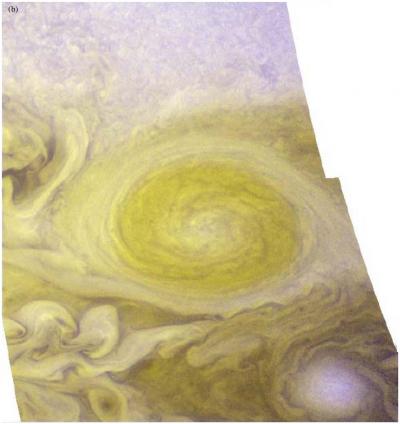It's left to bigger minds (and bigger telescopes) than mine to sort out what caused it but while the blogosphere has been buzzing, JPL has been observing.

Preliminary image showing a black mark in Jupiters South Polar Region (SPR). Weather, moon shadow or huge meteor/asteroid/comet impact? Image captured by Anthony Wesley on 19th July 2009 at 1554UTC from Murrumbateman Australia
Initially, some speculated it could be weather. Here is what weather on Jupiter looks like.
In this quasi-true-color view of Jupiter's Little Red Spot, generated using a New Horizons-LORRI mosaic in the red and green channels and a Hubble Space Telescope 410 nm map in the blue channel, the "LRS" appears with distinctly redder color than the south tropical disturbance to the north or the small oval to the southeast.
Image from June 2008 issue of the Astronomical Journal. Credit: NASA/Johns Hopkins University Applied Physics Laboratory/Southwest Research Institute/HST:

Here's what JPL now sees.

Image shows a large impact shown on the bottom left on Jupiter's south polar region captured on July 20, 2009, by NASA's Infrared Telescope Facility in Mauna Kea, Hawaii. This image was taken at 1.65 microns, a wavelength sensitive to sunlight reflected from high in Jupiter's atmosphere, and it shows both the bright center of the scar (bottom left) and the debris to its northwest (upper left). Credit: NASA/JPL/Infrared Telescope Facility
It's definitely a scar ... and exactly 15 years after the first impacts by the comet Shoemaker-Levy 9. Shoemaker-Levy 9 was a comet that broke into pieces before it hit Jupiter in 1994. Like that event, it's hard to know if this was a comet or an asteroid because they're both small, both primordial and both relatively plentiful around Jupiter.
The new infrared images show the impact point was near the south polar region, with a visibly dark mark and brighter upwelling particles in the upper atmosphere in near-infrared wavelengths, along with a warming of the upper troposphere with possible extra emission from ammonia gas detected at mid-infrared wavelengths.
"It could be the impact of a comet, but we don't know for sure yet," said Glenn Orton, a scientist at JPL. "It's been a whirlwind of a day, and this on the anniversary of the Shoemaker-Levy 9 and Apollo anniversaries is amazing."
Leigh Fletcher, a NASA postdoctoral student at JPL who worked with Orton during these latest observations and Tweeted about the developments as they happened said, "Given the rarity of these events, it's extremely exciting to be involved in these observations. These are the most exciting observations I've seen in my five years of observing the outer planets!"




Comments